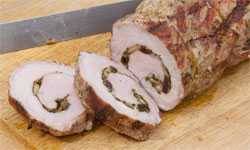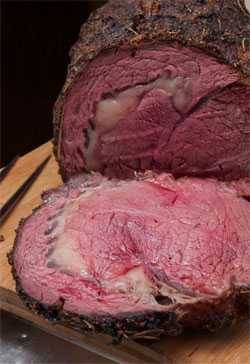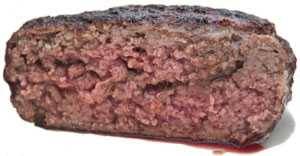On 5/24/2011 the US Department of Agriculture (USDA), with much fanfare, finally changed its cooking temp recommendations which were waaaay out of date and universally ignored by Chefs and skilled cooks. There has been a lot of press over this, but they really only changed one thing of significance, the recommendations for pork chops and pork roasts. I’m guessing the pork lobby spent big bucks and a lot of time camped at Secretary Tom Vilsack’s door. Makes me wonder where the beef lobby is sleeping.
One thing has not changed: If you follow USDA recommendations 100% you will be 100% safe and doomed to terrible steaks and lamb chops. And as usual, in its effort to make one set of easy to understand rules suitable for a refrigerator magnet, the government has oversimplified.
Here are the USDA’s new rules of thumb: 145°F for whole meats in the thickest part plus three minutes of rest, 160°F for ground meats and 165°F for all poultry.
The whole story, it should not surprise you, is a bit more complicated. In recent years there has been widespread contamination of our food supply, both animal and vegetable, with bacteria such as Salmonella, Escherichia coli O157:H7, Shigella, Listeria, and Clostridium botulinum as well as parasites. I understand the concept that simple rules are what most people need to battle this evil army, but it would have been nice if USDA had at least added a statement like this: “These are important guidelines and only knowledgeable and experienced chefs with high quality thermometers should veer from them. To understand all the facts, click here” with a link to an article like this one. As we dive into this important discussions I should point out here that I am not a food safety scientist, but my wife is, and she is also the editor of a food microbiology magazine, and we have discussed these matters at length.
Pork chops and roasts

The new recommendation for whole cuts of unground pork is 145°F (63°C) as measured with an accurate food thermometer placed in the thickest part of the meat, then allowing the meat to rest for three minutes before carving or consuming so the temp will rise a few more degrees.
This is a major breakthrough for pork quality. Pork chops are just plain juicier and more tender at the new “safe” temp of 145°F (they will probably rise to about 150°F during the 3 minute rest). At that temp pork will be very pale pink. You can make chops even better with about 30 to 60 minutes in a brine of about 5%. That’s about 1 cup of table salt or 2 cups Morton’s kosher salt, to 1 gallon of water. For more on brines and how to amp them up, click here.
There is good reason to make this change. Once upon a time it was easy to get the parasite trichinosis from undercooked pork. Today trichinosis has been all but eradicated in developed countries. Trichinosis is caused by eating raw or undercooked pork and some wild game infected with the larvae of a species of the parasitic worm, trichinella. The annual average is now fewer than 40 cases per year in the US, most associated with eating undercooked wild game such as bear. Trichinosis from pork was about five cases per year in 2006, mostly from eating uninspected home grown hogs. The number of cases in pork has decreased because of improved farming and processing methods as well as public awareness of the importance of proper cooking. Trichinosis is killed at 138°F.
- Click here for my stuffed pork loin recipe (above).
- Click here for my recipe for Kermit’s Second Favorite Pork Chop.
Poultry

USDA has not changed its recommendations for poultry products, including ground chicken and turkey, which remain at 165°F. Salmonella is common in commercial chicken, and it is often found in free-range and organic chicken, and every technical reference I have ever seen says that this temp is pretty much ironclad with one minor exception, sous vide, which I will discuss below. Poultry white meat, like “the other white meat”, also benefits from a short swim in salt water before cooking.
Other whole muscle meats

Alas, USDA still tells us to cook steaks, lamb chops, and roasts to 145°F with a 3 minute rest. This is actually a step backwards because they have added the three minute rest during which the meat temp will rise! It wasn’t in previous recommendations! At 145°F a steak is medium well, mostly tan/gray with a tinge of pink. At this temp it takes more effort for teeth to cut through the muscle fibers, much of the juices have congealed, and those juices are what carry most of the flavor to your taste buds so the meat is less tasty. If it rests for 3 minutes it gets mighty close to well-done, a terrible waste of good beef.
The optimum temp for tenderness, juiciness, and flavor of a steak is medium rare, about 130 to 135°F. Most steak lovers know this, and no steakhouse could stay in business if they followed the 145°F plus 3 minute guideline. At this temp you could trash all the prime rib carving stations in the nation. It is mindblowing that USDA has not come to grips with this reality.
As far as I can tell, there is little risk in eating medium rare or even rare steaks. I hope someone at USDA reads this. I’d like to see the data on food-borne illnesses from whole muscle meat steaks cooked to 130 to 135°F.
The biggest problem
The problem is that bacteria, especially virulent strains of Escherichia coli such as E-coli O157:H7 live in the intestines of cattle. E-coli comes out in their poop and get on cattle hides, especially when they are in close quarters like feedlots, called CAFOs. They can also be spilled on the slaughterhouse floor when cattle are slaughtered and the occasional sphincter lets loose. They also spill out if a butcher’s knife accidentally slits open an intestine and then they get on the blade. The nasties then get on the surface of the meat, but they do not get very far into the meat. But when you cook steaks, and most of us cook at much higher temps than 145°F, grills and frying pans and broilers are usually well over 300°F, e-coli and other bugs die almost instantly. That’s why it is a bad idea to use tenderizing devices like the Jaccard or a fork that puncture the skin and soften the meat by plunging into it. They are very effective inoculators, pushing contamination deep into the center.
Other ground meats
Ground meats other than poultry must be cooked to 160°F and do not require a rest time. This number has not changed and it means that you should not be serving pink hamburgers, especially to children and the elderly. Again, an ironclad line you should not cross, unless the meat has been irradiated. E-coli is not a trivial adversary. It can debilitate, kill kidneys, and even kill loved ones.
The problem is that if meat is contaminated in the butchering process, when it is ground, unlike steaks, the yucky stuff gets distributed throughout. So ground meats just must be cooked hotter or longer to kill the buggers down in the center.
Now I know a lot of you like red or pink burgers, but let me ask you to do a blind taste test next time you are in a favorite steakhouse. Order two burgers, one medium rare and one at 160F. Blindfold yourself and taste the two. It will be very hard to tell them apart. That’s because the meat has been pre-chewed! It has been supertenderized by the grinder. Unlike well done steaks, well done burgers are not significantly tougher. And since the best burgers are not made from lean meat, since they contain about 20% fat, even a 160F burger can be bib worthy.

But if you must have red or pink burgers, either buy irradiated meat (it is sterile), or pasteurize it yourself: Food scientists say that if you dip a piece steak in boiling water (212°F) for 10 seconds before grinding it yourself, it is made safe. I have tried it, and although the exterior turns gray, it grinds well and makes fine flavorful rare patties.
Moral: Unless your meat has been sterilized, cook burgers to 160°F. Why take the risk? Also, remember to wear your seat belt, and no smoking in bed. Same thing.



High quality websites are expensive to run. If you help us, we’ll pay you back bigtime with an ad-free experience and a lot of freebies!
Millions come to AmazingRibs.com every month for high quality tested recipes, tips on technique, science, mythbusting, product reviews, and inspiration. But it is expensive to run a website with more than 2,000 pages and we don’t have a big corporate partner to subsidize us.
Our most important source of sustenance is people who join our Pitmaster Club. But please don’t think of it as a donation. Members get MANY great benefits. We block all third-party ads, we give members free ebooks, magazines, interviews, webinars, more recipes, a monthly sweepstakes with prizes worth up to $2,000, discounts on products, and best of all a community of like-minded cooks free of flame wars. Click below to see all the benefits, take a free 30 day trial, and help keep this site alive.
Post comments and questions below
1) Please try the search box at the top of every page before you ask for help.
2) Try to post your question to the appropriate page.
3) Tell us everything we need to know to help such as the type of cooker and thermometer. Dial thermometers are often off by as much as 50°F so if you are not using a good digital thermometer we probably can’t help you with time and temp questions. Please read this article about thermometers.
4) If you are a member of the Pitmaster Club, your comments login is probably different.
5) Posts with links in them may not appear immediately.
Moderators